The Residential Voltage Regulator Market is estimated to be valued at USD 364.0 million in 2025 and is projected to reach USD 757.2 million by 2035, registering a compound annual growth rate (CAGR) of 7.6% over the forecast period. This growth, supported by a CAGR of 7.6%, is driven by the increasing demand for energy-efficient voltage regulation solutions in residential sectors, especially in emerging markets.
In the first five-year phase (2025–2030), the market is expected to grow from USD 364 million to USD 520 million, adding USD 156 million, which accounts for 39.6% of the total incremental growth, driven by the rising adoption of smart home technologies and renewable energy systems.
The second phase (2030–2035) is expected to contribute USD 237.2 million, representing 60.4% of the total growth, driven by the increasing demand for a stable and efficient power supply in residential areas. Annual increments will rise from USD 31 million in the early years to USD 57 million by 2035, driven by advancements in voltage regulation technologies, growing consumer awareness, and government initiatives to improve energy efficiency. Manufacturers focusing on smart, compact, and cost-effective voltage regulation solutions will capture the largest share of this USD 393.2 million opportunity.
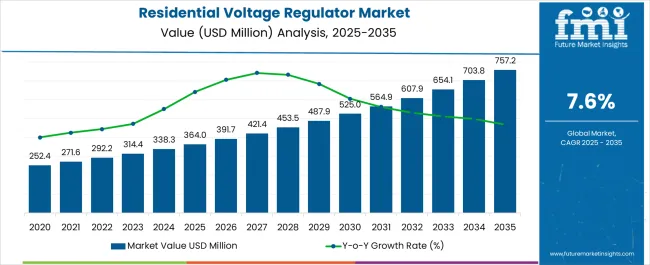
| Metric | Value |
|---|---|
| Residential Voltage Regulator Market Estimated Value in (2025 E) | USD 364.0 million |
| Residential Voltage Regulator Market Forecast Value in (2035 F) | USD 757.2 million |
| Forecast CAGR (2025 to 2035) | 7.6% |
The residential voltage regulator market is experiencing notable growth as demand for stable electricity supply continues to rise across urban and semi urban regions. Increasing dependence on voltage sensitive appliances, along with growing adoption of home automation systems, is fueling the requirement for reliable voltage regulation.
Power fluctuations in residential grids and rising incidences of voltage instability due to aging infrastructure have further driven consumer preference for dedicated voltage regulation solutions. Energy efficiency mandates and the growing shift toward smart and connected devices are also encouraging the integration of intelligent voltage regulators in residential setups.
The market outlook remains optimistic as consumers prioritize appliance protection, uninterrupted performance, and energy savings within evolving home energy ecosystems.
The residential voltage regulator market is segmented by product, phase, voltage, and geographic regions. By product, the residential voltage regulator market is divided into Linear and Switching. In terms of the phase, the residential voltage regulator market is classified into single-phase and three-phase.
Based on voltage, the residential voltage regulator market is segmented into ≤ 5 kVA, > 5 kVA to 20 kVA, and > 20 kVA to 40 kVA. Regionally, the residential voltage regulator industry is classified into North America, Latin America, Western Europe, Eastern Europe, Balkan & Baltic Countries, Russia & Belarus, Central Asia, East Asia, South Asia & Pacific, and the Middle East & Africa.
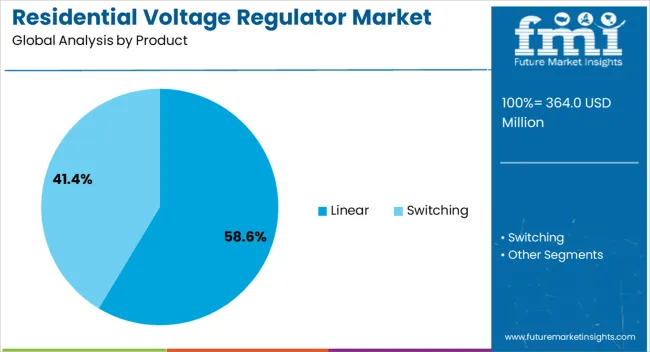
The linear segment is projected to contribute 58.60% of the overall market revenue by 2025 within the product category, establishing itself as the leading type. This growth is attributed to its ability to offer smooth and continuous voltage correction without introducing significant electrical noise.
Linear regulators are preferred for residential use due to their silent operation, minimal maintenance requirements, and consistent performance under low to moderate load conditions. Their relatively simple design and cost-effective manufacturing have supported wide adoption in standard household applications.
As consumers seek dependable voltage stabilization for sensitive home electronics and appliances, the linear segment maintains its dominance by delivering a balance of performance, affordability, and ease of integration.
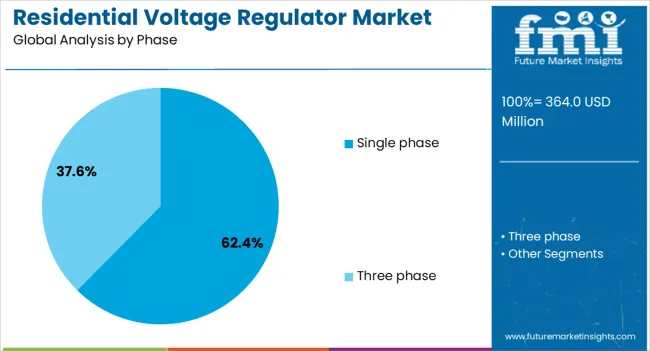
The single phase segment is expected to hold 62.40% of total revenue by 2025 within the phase category, making it the most dominant configuration. This is driven by the widespread use of single phase electrical systems in residential buildings and standalone homes across both developed and developing regions.
Single phase voltage regulators are easier to install, require less complex infrastructure, and cater efficiently to typical household power demands. Their compatibility with most domestic appliances, including lighting systems, refrigerators, and televisions, reinforces their demand.
Continued urbanization and residential construction are further supporting adoption, solidifying the segment’s leading market position.
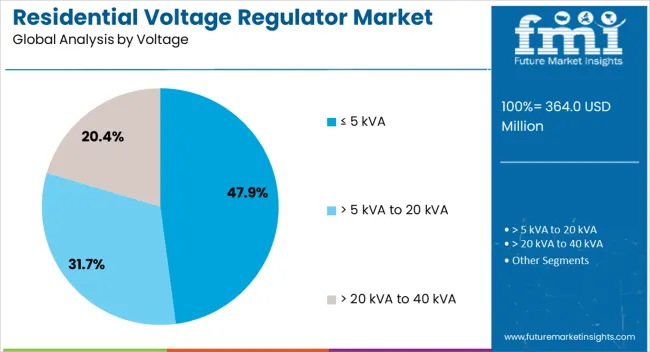
The segment rated at 5 kVA or below is expected to account for 47.90% of the total market share by 2025 under the voltage category, making it the preferred rating for residential use. This rating range aligns well with the power consumption needs of average households, ensuring sufficient capacity for essential appliances without incurring excessive installation costs.
Voltage regulators within this range are compact, energy efficient, and tailored for domestic settings where space and energy conservation are priorities.
As homeowners prioritize practical and scalable solutions, the 5 kVA and below segment continues to be the standard for everyday voltage regulation in the residential market.
The residential voltage regulator market is driven by the rising demand for stable and reliable power supply systems, with opportunities in expanding residential infrastructure and electrification. Emerging trends in smart voltage regulators are shaping the market, while challenges related to high costs and consumer awareness remain. By 2025, addressing these challenges through affordable solutions and consumer education will be crucial for continued market growth and widespread adoption of residential voltage regulators.
The residential voltage regulator market is witnessing growth due to the increasing demand for stable and reliable power supply solutions in residential areas. As electrical appliances and home systems become more sensitive to voltage fluctuations, the need for voltage regulators is rising. These devices help maintain a consistent voltage, preventing damage to electrical equipment. By 2025, the demand for residential voltage regulators is expected to grow as more households prioritize protecting their appliances and devices from voltage irregularities.
Opportunities in the residential voltage regulator market are expanding with the growth of residential infrastructure and electrification efforts. As more homes are built and connected to electricity grids, the demand for reliable voltage regulation increases. Additionally, as regions expand their electrification efforts, voltage regulators become essential for maintaining the quality of electricity distribution. By 2025, the market will see a steady increase in demand, particularly in developing regions, where the electrification of remote areas will require reliable voltage regulation systems for homes.
Emerging trends in the residential voltage regulator market include the development of smart voltage regulators that integrate with home energy management systems. These advanced devices allow homeowners to monitor and control the voltage regulation in real time through smartphone apps or smart home platforms. By incorporating IoT capabilities, smart voltage regulators can provide better energy management, enhance device protection, and improve overall energy efficiency. By 2025, these smart solutions will be increasingly adopted as consumers seek greater control over their energy consumption and appliance protection.
Despite growth, challenges such as high initial costs and limited consumer awareness remain in the residential voltage regulator market. The upfront cost of purchasing and installing voltage regulators can be a barrier for many households, particularly in regions where electricity supply may be unreliable but consumers are hesitant to invest in additional equipment. Furthermore, limited awareness about the importance of voltage regulation for appliance longevity hampers adoption. By 2025, overcoming these challenges will require educating consumers about the benefits of voltage regulators and providing affordable solutions.
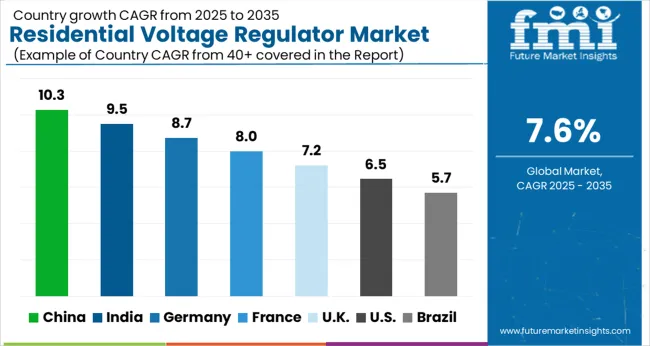
| Country | CAGR |
|---|---|
| China | 10.3% |
| India | 9.5% |
| Germany | 8.7% |
| France | 8.0% |
| UK | 7.2% |
| USA | 6.5% |
| Brazil | 5.7% |
The global residential voltage regulator market is projected to grow at a 7.6% CAGR from 2025 to 2035. China leads with a growth rate of 10.3%, followed by India at 9.5%, and Germany at 8.7%. The United Kingdom records a growth rate of 7.2%, while the United States shows the slowest growth at 6.5%. These varying growth rates are driven by increasing demand for efficient power distribution systems, growing awareness of energy conservation, and the need for voltage stability in residential homes. Emerging markets like China and India are experiencing higher growth due to rapid urbanization, industrial expansion, and increasing demand for electricity, while more mature markets like the USA and the UK see steady growth driven by technological advancements, energy efficiency initiatives, and the need for reliable power in residential areas. This report includes insights on 40+ countries; the top markets are shown here for reference.
The residential voltage regulator market in China is growing rapidly, with a projected CAGR of 10.3%. China’s expanding urbanization, rapid industrial growth, and increasing demand for electricity are key drivers of market growth. As the country continues to upgrade its power distribution infrastructure and improve grid reliability, the need for voltage regulation in residential areas is rising. Additionally, China’s growing focus on energy efficiency, sustainability, and environmental regulations further accelerates the adoption of residential voltage regulators. The increasing consumer demand for reliable, high-quality electricity supply in homes, coupled with government policies promoting smart grid technologies, continues to drive the market forward.
The residential voltage regulator market in India is projected to grow at a CAGR of 9.5%. India’s rapidly growing population, expanding urban areas, and increasing demand for electricity are fueling the need for reliable and efficient voltage regulation solutions in residential areas. The country’s ongoing investments in power infrastructure, along with the growing focus on improving electricity quality and stability, further contribute to the market growth. Additionally, India’s increasing adoption of energy-efficient and eco-friendly technologies, combined with rising awareness about voltage-related issues in residential homes, accelerates the demand for residential voltage regulators.
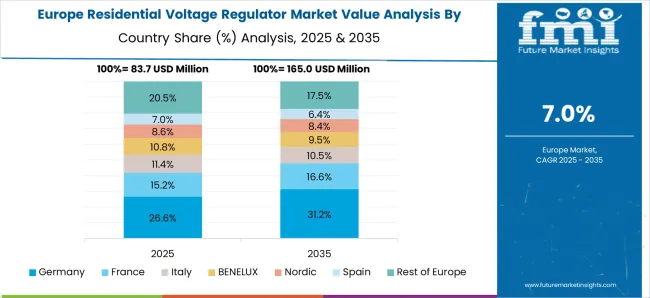
The residential voltage regulator market in Germany is projected to grow at a CAGR of 8.7%. Germany’s demand for residential voltage regulators is driven by the increasing adoption of smart grid technologies, along with a focus on improving energy efficiency and reliability in residential electricity supply. The country’s commitment to sustainability and reducing carbon emissions is encouraging the use of energy-efficient voltage regulation solutions. Additionally, Germany’s well-established regulatory environment, which emphasizes the importance of grid stability and quality of supply, further accelerates the adoption of residential voltage regulators in urban and rural homes.
The residential voltage regulator market in the United Kingdom is projected to grow at a CAGR of 7.2%. The UK increasing focus on improving residential electricity supply, coupled with the growing demand for energy-efficient and reliable voltage regulation solutions, is driving steady market growth. The country’s ongoing transition to renewable energy, coupled with the government’s support for smart grid technologies and power infrastructure upgrades, further contributes to the adoption of residential voltage regulators. Additionally, the rising awareness about the importance of voltage stability in residential homes and the push for energy conservation are supporting market expansion in the UK

The residential voltage regulator market in the United States is expected to grow at a CAGR of 6.5%. The USA market remains steady, driven by the increasing demand for reliable and energy-efficient voltage regulation solutions in residential homes. The growing adoption of smart homes, energy-efficient appliances, and the integration of renewable energy sources are driving the need for advanced voltage regulation solutions. Additionally, the country’s focus on grid modernization, energy conservation, and the rising concern over voltage fluctuations in residential areas are further contributing to the market’s steady growth.

The residential voltage regulator market is dominated by ABB, which leads with its advanced voltage regulation solutions designed to provide stable power supply and protect sensitive home appliances from voltage fluctuations. ABB’s dominance is supported by its innovative technology, global presence, and deep expertise in providing reliable and energy-efficient voltage regulation systems.
Key players such as Eaton, Siemens, and GE Vernova maintain significant market shares by offering high-performance voltage regulators that ensure continuous, reliable power supply for residential buildings, preventing damage to electrical systems and appliances. These companies focus on enhancing product reliability, reducing energy consumption, and integrating smart features for better control and monitoring.
Emerging players like Analog Devices, Basler Electric, and Microchip Technologies are expanding their market presence by offering specialized voltage regulation solutions tailored for niche residential applications, such as energy-efficient homes, renewable energy systems, and smart homes. Their strategies include enhancing performance accuracy, prioritizing energy conservation, and offering scalable solutions for small to medium-sized households.
The increasing adoption of smart homes drives market growth, as does the need for reliable power in residential areas and the growing awareness of energy-saving technologies. Innovations in digital voltage regulation, IoT integration, and renewable energy integration are expected to continue shaping competitive dynamics and drive further growth in the global residential voltage regulator market.
| Item | Value |
|---|---|
| Quantitative Units | USD 364.0 Million |
| Product | Linear and Switching |
| Phase | Single phase and Three phase |
| Voltage | ≤ 5 kVA, > 5 kVA to 20 kVA, and > 20 kVA to 40 kVA |
| Regions Covered | North America, Europe, Asia-Pacific, Latin America, Middle East & Africa |
| Country Covered | United States, Canada, Germany, France, United Kingdom, China, Japan, India, Brazil, South Africa |
| Key Companies Profiled | ABB, Analog Devices, Basler Electric, BTRAC, Eaton, GE Vernova, Infineon Technologies, Legrand, Maschinenfabrik Reinhausen, Microchip Technologies, NXP Semiconductors, Purevolt, Renesas Electronics, Ricoh USA, ROHM, Selec Controls, Selvon Instruments, SEMTECH, Siemens, STMicroelectronics, TOREX SEMICONDUCTOR, Toshiba America Energy Systems Corporation, Vicor, and Vishay Intertechnology |
| Additional Attributes | Dollar sales by regulator type and application, demand dynamics across residential, commercial, and industrial sectors, regional trends in residential voltage regulator adoption, innovation in energy-efficient and smart grid technologies, impact of regulatory standards on power quality and safety, and emerging use cases in renewable energy integration and smart home systems. |
The global residential voltage regulator market is estimated to be valued at USD 364.0 million in 2025.
The market size for the residential voltage regulator market is projected to reach USD 757.2 million by 2035.
The residential voltage regulator market is expected to grow at a 7.6% CAGR between 2025 and 2035.
The key product types in residential voltage regulator market are linear and switching.
In terms of phase, single phase segment to command 62.4% share in the residential voltage regulator market in 2025.






Our Research Products

The "Full Research Suite" delivers actionable market intel, deep dives on markets or technologies, so clients act faster, cut risk, and unlock growth.

The Leaderboard benchmarks and ranks top vendors, classifying them as Established Leaders, Leading Challengers, or Disruptors & Challengers.

Locates where complements amplify value and substitutes erode it, forecasting net impact by horizon

We deliver granular, decision-grade intel: market sizing, 5-year forecasts, pricing, adoption, usage, revenue, and operational KPIs—plus competitor tracking, regulation, and value chains—across 60 countries broadly.

Spot the shifts before they hit your P&L. We track inflection points, adoption curves, pricing moves, and ecosystem plays to show where demand is heading, why it is changing, and what to do next across high-growth markets and disruptive tech

Real-time reads of user behavior. We track shifting priorities, perceptions of today’s and next-gen services, and provider experience, then pace how fast tech moves from trial to adoption, blending buyer, consumer, and channel inputs with social signals (#WhySwitch, #UX).

Partner with our analyst team to build a custom report designed around your business priorities. From analysing market trends to assessing competitors or crafting bespoke datasets, we tailor insights to your needs.
Supplier Intelligence
Discovery & Profiling
Capacity & Footprint
Performance & Risk
Compliance & Governance
Commercial Readiness
Who Supplies Whom
Scorecards & Shortlists
Playbooks & Docs
Category Intelligence
Definition & Scope
Demand & Use Cases
Cost Drivers
Market Structure
Supply Chain Map
Trade & Policy
Operating Norms
Deliverables
Buyer Intelligence
Account Basics
Spend & Scope
Procurement Model
Vendor Requirements
Terms & Policies
Entry Strategy
Pain Points & Triggers
Outputs
Pricing Analysis
Benchmarks
Trends
Should-Cost
Indexation
Landed Cost
Commercial Terms
Deliverables
Brand Analysis
Positioning & Value Prop
Share & Presence
Customer Evidence
Go-to-Market
Digital & Reputation
Compliance & Trust
KPIs & Gaps
Outputs
Full Research Suite comprises of:
Market outlook & trends analysis
Interviews & case studies
Strategic recommendations
Vendor profiles & capabilities analysis
5-year forecasts
8 regions and 60+ country-level data splits
Market segment data splits
12 months of continuous data updates
DELIVERED AS:
PDF EXCEL ONLINE
Linear Residential Voltage Regulator Market Size and Share Forecast Outlook 2025 to 2035
Switching Residential Voltage Regulator Market Size and Share Forecast Outlook 2025 to 2035
Three Phase Residential Voltage Regulator Market Size and Share Forecast Outlook 2025 to 2035
Single Phase Residential Voltage Regulator Market Size and Share Forecast Outlook 2025 to 2035
Voltage Regulator Market Size and Share Forecast Outlook 2025 to 2035
Voltage Regulator For Advanced Semiconductor Market Size and Share Forecast Outlook 2025 to 2035
Low Voltage Residential Switchgear Market Size and Share Forecast Outlook 2025 to 2035
Medium Voltage Residential Switchgear Market Size and Share Forecast Outlook 2025 to 2035
Linear Voltage Regulators Market
Fixed Cycle Regulator Residential Power Conditioner Market Size and Share Forecast Outlook 2025 to 2035
Switching Commercial Voltage Regulator Market Size and Share Forecast Outlook 2025 to 2035
Three Phase Commercial Voltage Regulator Market Size and Share Forecast Outlook 2025 to 2035
Single Phase Commercial Voltage Regulator Market Size and Share Forecast Outlook 2025 to 2035
Voltage Monitoring Integrated Circuit Market Size and Share Forecast Outlook 2025 to 2035
Residential Generator Market Size and Share Forecast Outlook 2025 to 2035
Residential Energy-Efficient Technologies Market Size and Share Forecast Outlook 2025 to 2035
Residential Interior Wood Doors Market Size and Share Forecast Outlook 2025 to 2035
Voltage Tester Market Size and Share Forecast Outlook 2025 to 2035
Residential Air-to-Air Heat Pump Market Size and Share Forecast Outlook 2025 to 2035
Residential Automatic Motor Starter Market Size and Share Forecast Outlook 2025 to 2035

Thank you!
You will receive an email from our Business Development Manager. Please be sure to check your SPAM/JUNK folder too.
Chat With
MaRIA